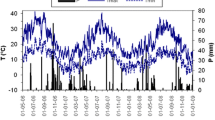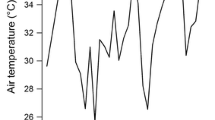Abstract
The effect of short-term flooding was examined in 2-year-old apricot trees (Prunus armeniaca cv. Búlida). Six apricot trees of similar appearance were submitted to two treatments: three were irrigated daily, while the others were flooded for a period of 50 h by submerging the pots in plastic water tanks. The trees were removed from the water, drained and then placed in the same conditions as the control plants. A decrease in transpiration in the flooded trees with respect to the control plants was evident. The daily pattern of soil O2 concentration and plant hydraulic resistance followed a similar trend during the flooding. However, this relationship was not maintained throughout the experiment, since the O2 values increased rapidly when the waterlogging ceased, while plant hydraulic resistance only recovered at the end of the experiment when the original root system, damaged by flooded conditions, was replaced with new roots. In flooded trees, the midday leaf water potential decreased progressively from the beginning of flooding, but gradually recovered when the waterlogging ceased. Leaf conductance values of treated plants were slow to recover, reaching values of the control plants 8 days after the leaf water potential had recovered. The close relationship observed during most of the experiment between the leaf water parameters, leaf conductance and plant hydraulic conductance indicate that hydraulic messages are likely to play a dominant role in co-ordinating the observed responses of the shoot.





Similar content being viewed by others
References
Alarcón JJ, Domingo R, Green SR, Sánchez-Blanco MJ, Rodríguez P, Torrecillas A (2000) Sap flow as an indicator of transpiration and the water status of young apricot trees. Plant Soil 227:77–85
Alarcón JJ, Domingo R, Green SR, Nicolás E, Torrecillas A (2003) Estimation of hydraulic conductance within field-grown apricot using sap flow measurements. Plant Soil 251:125–135
Andersen PC, Lombani PB, Westwood MN (1984) Leaf conductance, growth, and survival of willow and deciduous fruit tree species under flooded soil conditions. J Am Soc Hortic Sci 109:132–138
Beckman C, Perry RL, Flore JA (1992) Short-term flooding affects gas exchange characteristics of containerised sour cherry trees. HortScience 27:1297–1301
Bradford KJ, Yang SF (1981) Physiological responses of plants to waterlogging. J Hortic Sci 16:25–30
Crawford RMM (1982) Physiological responses to flooding. In: Lange OL, Noble PS, Osmond CB, Ziegler H (eds) Physiological plant ecology. Vol II: water relations and carbon assimilation. Encyclopedia of plant physiology, new series. Springer, Berlin Heidelberg New York, pp 453–477
Davies FS, Flore JA (1986) Flooding, gas exchange and hydraulic conductivity of highbush blueberry. Physiol Plant 67:545–551
Dell’Amico J, Torrecillas A, Rodriguez P, Morales D, Sánche-Blanco MJ (2001) Differences in the effects of flooding the soil early and late in the photoperiod on the water relations of pot-grown tomato plants. Plant Sci 160:481–487
Domingo R, Pérez-Pastor A, Ruiz-Sánchez MC (2002) Physiological responses of apricot plants grafted on two different rootstocks to flooding conditions. J Plant Physiol 159:725–732
Edwards WRN, Warrick NWM (1984) Transpiration from a kiwifruit vine as estimated by the heat-pulse technique and the Penman–Monteith equation. N Z J Agric Res 27:537–543
Else MA, Davies WJ, Malone M, Jackson MB (1995) A negative hydraulic message form oxygen-deficient roots of tomato plants. Plant Physiol 109:1017–1024
Else MA, Tikstra AE, Croker SJ, Davies WJ, Jakson MB (1996) Stomatal closure in flooded tomato plants involves abscisic acid and a chemically unidentified anti-transpirant in xylem sap. Plant Physiol 112:239–247
Erikson NE (1989) Survival of plant materials established on a floodplain in central Oklahoma. Wildl Soc Bull 17:63–65
Green SR, Clothier BE (1988) Water use of kiwifruit vines and apple trees by the heat-pulse technique. J Exp Bot 39:115–123
Gucci R, Xiloyannis C, Flore JA (1991) Gas exchange parameters water relations and carbohydrate partitioning in leaves of field-grown Prunus domestica following fruit removal. Physiol Plant 83:497–505
Hiron RWP, Wright STC (1973) The role of endogenous abscisic acid in the response of plants to stress. J Exp Bot 4:769–781
Holbrook NM, Zwieniecki MA (2003) Water gate. Nature 425:361
Hook DD, Scholtens JR (1978) Adaptation and flood tolerance of tree species. In: Hook DD, Crawford RMM (eds) Plant life in anaerobic environments. Ann Arbor Science, Ann Arbor, pp 299–331
Jackson MB, Drew MC (1984) Effects of flooding on growth and metabolism of herbaceous plants. In: Kozlowski TT (ed) Flooding and plant growth. Academic, Orlando, pp 47–128
Jackson MB, Hall KC (1987) Early stomatal closure in waterlogged pea plants is mediated by abscisic acid in the absence of foliar water deficits. Plant Cell Environ 10:121–130
Jackson MB, Kowalewska AKB (1983) Positive and negative messages from roots induce foliar dessication and stomatal closure in flooded pea plants. J Exp Bot 34:493–506
Jackson MB, Gales K, Campbell DJ (1978) Effect of waterlogged soil conditions on the production of ethylene and on water relationships in tomato plants. J Exp Bot 29:183–193
Kawase M (1981) Anatomical and morphological adaptations of plants to water-logging. HortScience 16:8–12
Kozlowski TT (1984) Responses of woody plants to flooding. In: Kozlowski TT (ed) Flooding and plant growth. Academic, Orlando, pp 129–163
Kozlowski TT (1997) Responses of woody plants to flooding and salinity. Tree Physiol 1:1–22
Kozlowski TT, Pallardy SG (1979) Stomatal responses of Fraxinus pennsylvanica seedlings during and after flooding. Physiol Plant 46:155–158
Nicoll BC, Coutts MP (1998) Timing of root dormancy and tolerance to root waterlogging in clonal Sitka spruce. Trees 12:241–245
Pezeshki SR, Chambers JL (1985) Stomatal and photosynthetic response of sweet gum (Liquidambar styraciflua) to flooding. Can J For Res 15:371–375
Reece CF, Riha SJ (1991) Role of root systems of eastern larch and whit spruce in response to flooding. Plant Cell Environ 14:229–234
Ruiz-Sánchez MC, Domingo R, Morales D, Torrecillas A (1996) Water relations of Fino lemon plants on tow rootstocks under flooded conditions. Plant Sci 120:119–125
Sánchez-Blanco MJ, Alarcón JJ, Planes J, Torrecillas A (1994) Differential flood stress resistance of two almond cultivars based on survival, growth and water relations as stress indicators. J Hortic Sci 69:947–953
Sands R, Theodorou C (1978) Water uptake by mycorrhizal roots of radiata pine seedlings. Aust J Plant Physiol 5:301–309
Savé R, Serrano L (1986) Some physiological and growth responses of kiwi fruit (Actinidia chinensis) to flooding. Physiol Plant 66:75–78
Savé R, Biel C, Domingo R, Ruiz-Sánchez MC, Torrecillas A (1995) Some physiological and morphological characteristics of citrus plants for drought resistance. Plant Sci 110:167–172
Schaffer B, Ploetz RC (1989) Gas exchange characteristics as indicators of damage thresholds for phytopthora root of flooded and nonflooded avocado trees. HortScience 24:653–655
Scholander PF, Hammel HT, Bradstreet ED, Hemmingsen EA (1965) Sap pressure in vascular plants. Science 148:339–346
Shul’ga VD, Maksimov AN (1991) Effect of soil flooding on the conditions of forests in the Volga-Aktubinskaya floodplain. Sov Soil Sci 23:36–42
Smit B, Stachowiak M, Van Volkenburgh E (1988) Cellular processes limiting leaf growth in plants under hypoxic root stress. J Exp Bot 40:89–94
Smith GS, Buwalda JG, Green TG, Clark CJ (1989) Effect of oxygen supply and temperature at the root on the physiology of kiwifruit vines. New Phytol 113:431–437
Smith GS, Judd MJ, Miller SA, Buwalda JG (1990) Recovery of kiwifruit vines from transient waterlogging of the root system. New Phytol 115:325–333
Swanson RH, Whitfield DWA (1981) Significant historical developments in thermal methods for measuring sap flow in trees. J Exp Bot 32:221–239
Syvertsen JP, Zablotowicz RM, Smith ML (1983) Soil temperature and flooding effects on two species of citrus. I. Plant growth and hydraulic conductivity. Plant Soil 72:3–12
Torrecillas A, Alarcón JJ, Domingo R, Planes J, Sánchez-Blanco MJ (1996) Strategies for drought resistance in leaves of two almond cultivars. Plant Sci 118:135–143
Tournaire-Roux C, Sutka M, Javot H, Gout E, Gerbeau P, Luu DT, Bligny R, Maurel C (2003) Cytosolic pH regulates root water transport during anoxid stress through gating of aquaporins. Nature 425:393–397
Tsukahara H, Kozlowski TT (1985) Importance of adventitious roots to growth of flooded Platanus occidentalis seedlings. Plant Soil 88:123–132
Turner NC (1988) Measurement of plant water status by the pressure chamber technique. Irrig Sci 17:59–73
Wazir FK, Smith MW, Akers SW (1988) Effects of flooding on phosphorous levels in pecan seedlings. HortScience 23:595–597
Wigley TB, Filer TH (1989) Characteristics of greentree reservoir: a survey of managers. Wildl Soc Bull 17:136–142
Zaerr J (1983) Short term flooding and net photosynthesis in seedlings of three conifers. For Sci 29:71–73
Zhang J, Davies WJ (1986) Chemical and hydraulic influences on the stomata of flooded plants. J Exp Bot 37:1479–1491
Zhang J, Davies WJ (1990) Changes in the concentration of ABA in xylem sap as a function of changing soil water status can account for changes in leaf conductance and growth. Plant Cell Environ 13:277–286
Acknowledgements
The study was supported by two projects: “Riego inteligente para un manejo sostenible en frutales” (CYCIT-AGL2000-0387-CO5-O4) and “Desarrollo de un equipo autónomo para la medición de caudal de savia en plantas leñosas” (PETRI-95-0693-01).
Author information
Authors and Affiliations
Corresponding author
Rights and permissions
About this article
Cite this article
Nicolás, E., Torrecillas, A., Dell’Amico, J. et al. The effect of short-term flooding on the sap flow, gas exchange and hydraulic conductivity of young apricot trees. Trees 19, 51–57 (2005). https://doi.org/10.1007/s00468-004-0362-7
Received:
Accepted:
Published:
Issue Date:
DOI: https://doi.org/10.1007/s00468-004-0362-7




